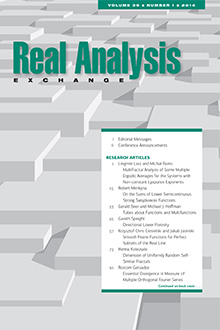Abstract
It is well-known that for a given continuous function \(f\), \(f(0)=f(1)\) and for any natural number \(n\) there exist \(x_n\), \(y_n=x_n + 1/n\) such that \(f(x_n)=f(y_n)\). It is also known that if the graph of \(f\) (or more generally a planar curve connecting the point 0 and 1) does not have a horizontal chord of length \(a\) and \(b\) respectively then there is no horizontal chord of length \(a+b\) either (see \cite{YY}). It is almost immediate that the lengths of possible horizontal chords of \(f\) form a closed set \(F\) of the unit interval [0,1], and according to the remark above its complement \(G=[0,1]\setminus F\) is an additive set: \(a\in G\), \(b\in G\), \(a+b\le 1\) imply \(a+b \in G\). C. Ryll-Nardzewski, Z. Romanowicz and M. Morayne raised the problem whether this additive property is not just necessary but also sufficient for a set to be the complement of the chord-set of some continuous function. In this paper we answer their question affirmatively.
Citation
Marianna Csörnyei. "On the chord set of continuous functions." Real Anal. Exchange 22 (2) 853 - 855, 1996/1997.
Information





